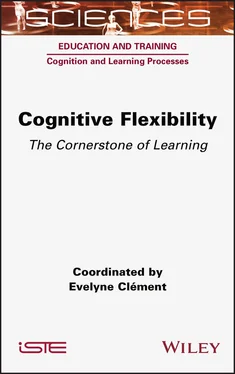Evelyne Clement - Cognitive Flexibility
Здесь есть возможность читать онлайн «Evelyne Clement - Cognitive Flexibility» — ознакомительный отрывок электронной книги совершенно бесплатно, а после прочтения отрывка купить полную версию. В некоторых случаях можно слушать аудио, скачать через торрент в формате fb2 и присутствует краткое содержание. Жанр: unrecognised, на английском языке. Описание произведения, (предисловие) а так же отзывы посетителей доступны на портале библиотеки ЛибКат.
- Название:Cognitive Flexibility
- Автор:
- Жанр:
- Год:неизвестен
- ISBN:нет данных
- Рейтинг книги:4 / 5. Голосов: 1
-
Избранное:Добавить в избранное
- Отзывы:
-
Ваша оценка:
- 80
- 1
- 2
- 3
- 4
- 5
Cognitive Flexibility: краткое содержание, описание и аннотация
Предлагаем к чтению аннотацию, описание, краткое содержание или предисловие (зависит от того, что написал сам автор книги «Cognitive Flexibility»). Если вы не нашли необходимую информацию о книге — напишите в комментариях, мы постараемся отыскать её.
Cognitive Flexibility — читать онлайн ознакомительный отрывок
Ниже представлен текст книги, разбитый по страницам. Система сохранения места последней прочитанной страницы, позволяет с удобством читать онлайн бесплатно книгу «Cognitive Flexibility», без необходимости каждый раз заново искать на чём Вы остановились. Поставьте закладку, и сможете в любой момент перейти на страницу, на которой закончили чтение.
Интервал:
Закладка:
Burgess, P.W. and Shallice, T. (1996). Response suppression, initiation and strategy use following frontal lobe lesions. Neuropsychologia , 34(4), 263–273.
Cartwright, K.B., Marshall, T.R., Huemer, C.M., Payne, J.B. (2019). Executive function in the classroom: Cognitive flexibility supports reading fluency for typical readers and teacher-identified low-achieving readers. Research in Developmental Disabilities , 88, 42–52.
Clément, E. (2006). Approche de la flexibilité cognitive dans la problématique de la résolution de problème. L’Année psychologique , 106(03), 415.
Clément, E. and Gavornikova-Baligand, Z. (2010). Étude des stratégies d’adultes présentant un retard mental dans la résolution de la Twenty Questions Task. Psychologie Française , 55(1), 25–39.
Colzato, L.S. (2010). DOOM’d to switch: Superior cognitive flexibility in players of first person shooter games. Frontiers in Psychology , 1, 8.
D’Elia, L.F., Satz, P., Uchiyama, C.L., White, T. (1996). Color trails test. Professional manual. Psychological Assessment Resources, Odessa, FL.
Delis, D.C., Kaplan, E., Kramer, J. (2001). Delis Kaplan Executive Function System . The Psychological Corporation, San Antonio, TX.
Dennis, J.P. and Vander Wal, J.S. (2010). The cognitive flexibility inventory: Instrument development and estimates of reliability and validity. Cognitive Therapy and Research , 34(3), 241–253.
Doebel, S. and Zelazo, P.D. (2015). A meta-analysis of the dimensional change card sort: Implications for developmental theories and the measurement of executive function in children. Developmental Review , 38, 241–268.
Eslinger, P.J. and Grattan, L.M. (1993). Frontal lobe and frontal-striatal substrates for different forms of human cognitive flexibility. Neuropsychologia , 31, 17–28.
Espy, K.A. and Cwik, M.F. (2004). The development of a trial making test in young children: The TRAILS-P. Clinical Neuropsychologist , 18(3), 411–422.
Fourneret, P. and Portes, V. (2017). Approche développementale des fonctions exécutives : du bébé à l’adolescence [Online]. Available at: https://www.emconsulte.com/en/article/1099322.
Frye, D., Zelazo, P.D., Palfai, T. (1995). Theory of mind and rule-based reasoning. Cognitive Development , 10(4), 483–527.
Gabrys, R.L., Tabri, N., Anisman, H., Matheson, K. (2018). Cognitive control and flexibility in the context of stress and depressive symptoms: The cognitive control and flexibility questionnaire. Frontiers in Psychology , 9, 2219.
Georgsdottir, A. and Lubart, T. (2003). La flexibilité cognitive et la créativité : une approche développementale, différentielle et expérimentale. Psychologie française , 48(3), 29–40.
Gioia, G.A., Isquith, P.K., Guy, S.C., Kenworthy, L. (2000). BRIEF: Behavior Rating Inventory of Executive Function. Psychological Assessment Resources, PAR-USA, Lutz, FL.
Gioia, G.A., Espy, K.A., Isquith, P.K. (2003). BRIEF-P: Behavior Rating Inventory of Executive Function – Preschool Version. Psychological Assessment Resources, PAR-USA, Lutz, FL.
Grant, D.A. and Berg, E.A. (1948). A behavioral analysis of degree of reinforcement and ease of shifting to new responses in a Weigl-type card-sorting problem. Journal of Experimental Psychology , 38, 404–411.
Hughes, C., Russell, J., Robbins, T.W. (1994). Evidence for executive dysfunction in autism. Neuropsychologia , 32(4), 477–492.
Isquith, P.K., Gioia, G.A., Espy, K.A. (2004). Executive function in preschool children: Examination through everyday behavior. Developmental Neuropsychology , 26, 403–422.
Jersild, A.T. (1927). Mental set and shift. Archives of Psychology , 89.
Karle, J.W., Watter, S., Shedden, J.M. (2010). Task switching in video game players: Benefits of selective attention but not resistance to proactive interference. Acta Psychologica , 134(1), 70–78.
Karmiloff-Smith, A. (1990). Constraints on representational change: Evidence from children’s drawing. Cognition , 34, 57–83.
Karmiloff-Smith, A. (1992). Beyond Modularity: A Developmental Perspective on Cognitive Science. MIT Press, Cambridge.
Karmiloff-Smith, A. (1994). Precis of beyond modularity: A developmental perspective on cognitive science. Behavioral and Brain Sciences , 17, 693–745.
Korkman, M., Kirk, U., Kemp, S. (2012). Bilan neuropsychologique de l’enfant , 2nd edition. Éditions du Centre de Psychologie Appliquée, Paris.
Lange, F., Brückner, C., Knebel, A., Seer, C., Kopp, B. (2018). Executive dysfunction in Parkinson’s disease: A meta-analysis on the Wisconsin Card Sorting Test literature. Neuroscience & Biobehavioral Reviews , 93, 38–56.
Lehto, J.E. and Uusitalo, A.-K. (2006). Rule detection in preschool-aged children. European Journal of Developmental Psychology , 3, 209–221.
Maintenant, C. and Blaye, A. (2008). Développement de la flexibilité catégorielle de 3 à 8 ans : rôle des aspects conceptuels. L’Année psychologique , 108(04), 659.
Maintenant, C. and Pennequin, V. (2016). Développement de la flexibilité catégorielle : rôles respectifs de la conceptualisation de relations et des forces d’association. L’Année psychologique , 116(01), 21–44.
Maintenant, C., Blaye, A., Paour, J.-L. (2011). Semantic categorical flexibility and aging: Effect of semantic relations on maintenance and switching. Psychology and Aging , 26(2), 461–466.
Maintenant, C., Blaye, A., Pennequin, V., Paour, J. (2013). Predictors of semantic categorical flexibility in older adults. British Journal of Psychology , 104(2), 265–282.
Manly, T., Anderson, V., Nimmo-Smith, I., Turner, A., Watson, P., Robertson, I.H. (2001). The differential assessment of children’s attention: The Test of Everyday Attention for Children (TEA-Ch), normative sample and ADHD performance. Journal of Psychology and Psychiatry , 42(8), 1065–1081.
Martin, M.M. and Rubin, R.B. (1995). A new measure of cognitive flexibility. Psychological Reports , 76(2), 623–626.
Mayr, U. (2001). Age differences in the selection of mental sets: The role of inhibition, stimuli ambiguity and response-set overlap. Psychology and Aging , 16 , 96–109.
Mayr, U. and Bell, T. (2006). On how to be unpredictable: Evidence from the voluntary task-switching paradigm. Psychological Science , 17, 774–780.
Miyake, A. and Friedman, N.P. (2012). The nature and organization of individual differences in executive functions: Four general conclusions. Current Directions in Psychological Science , 21, 8–14.
Miyake, A., Friedman, N.P., Emerson, M.J., Witzki, A.H., Howerter, A., Wager, T.D. (2000). The unity and diversity of executive functions and their contributions to complex “frontal lobe” tasks: A latent variable analysis. Cognitive Psychology , 41(1), 49–100.
Monsell, S. (2003). Task switching. Trends in Cognitive Sciences , 7(3), 134–140.
Müller, U., Zelazo, P.D., Imrisek, S. (2005). Executive function and children’s understanding of false belief: How specific is the relation? Cognitive Development , 20(2), 173–189.
Munakata, Y., Michaelson, L., Barker, J., Chevalier, N. (2013). Le fonctionnement exécutif pendant la petite enfance et l’enfance. In Encyclopédie sur le développement des jeunes enfants [Online]. Available at: http://www.enfantencyclopedie.com/fonctions-executives/selon-experts/le-fonctionnement-executifpendant-la-petite-enfance-et-lenfance.
Navon, D. (1977). Forest before trees: The precedence of global features in visual perception. Cognitive Psychology , 9(3), 353–383.
Читать дальшеИнтервал:
Закладка:
Похожие книги на «Cognitive Flexibility»
Представляем Вашему вниманию похожие книги на «Cognitive Flexibility» списком для выбора. Мы отобрали схожую по названию и смыслу литературу в надежде предоставить читателям больше вариантов отыскать новые, интересные, ещё непрочитанные произведения.
Обсуждение, отзывы о книге «Cognitive Flexibility» и просто собственные мнения читателей. Оставьте ваши комментарии, напишите, что Вы думаете о произведении, его смысле или главных героях. Укажите что конкретно понравилось, а что нет, и почему Вы так считаете.












